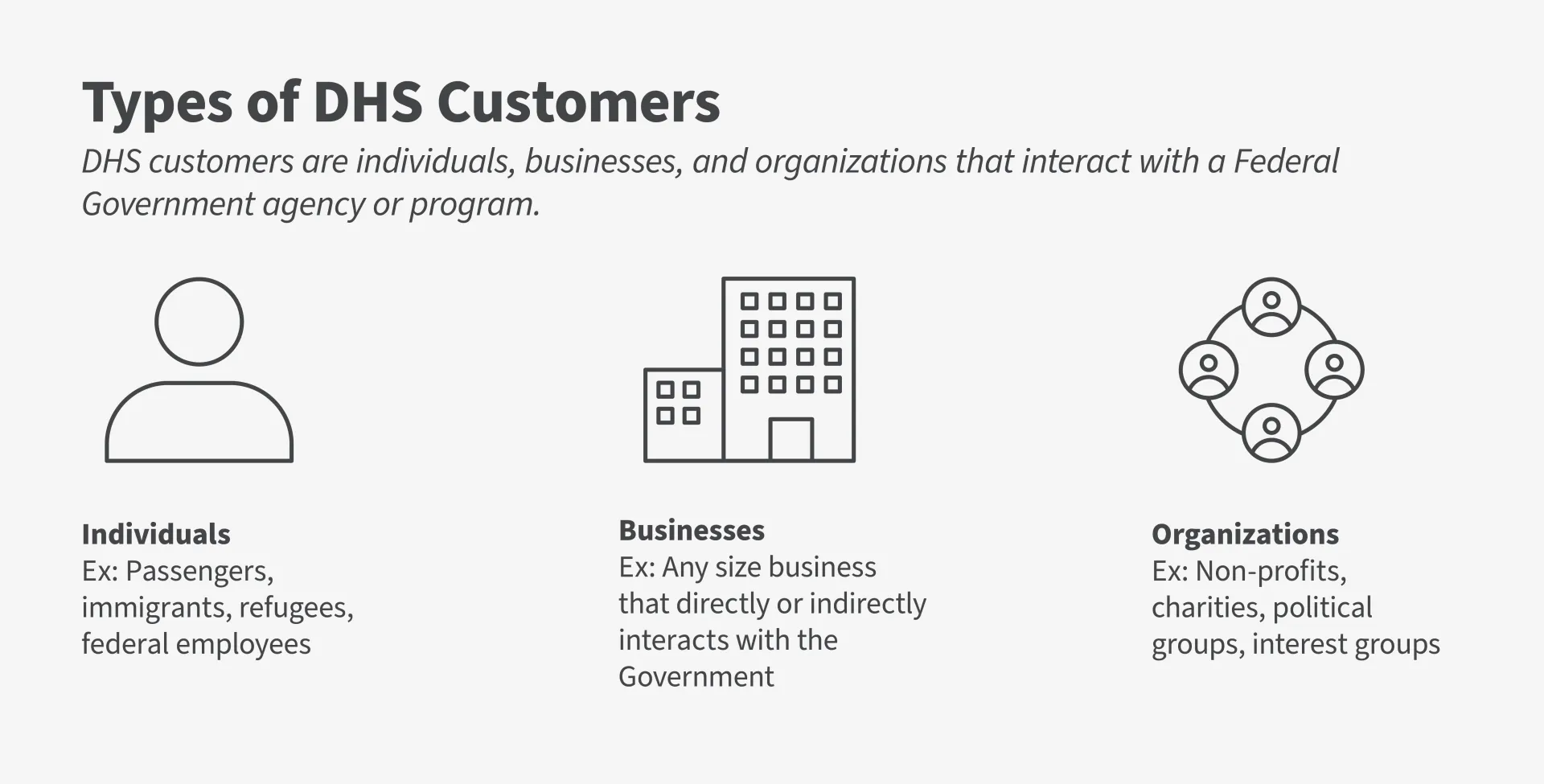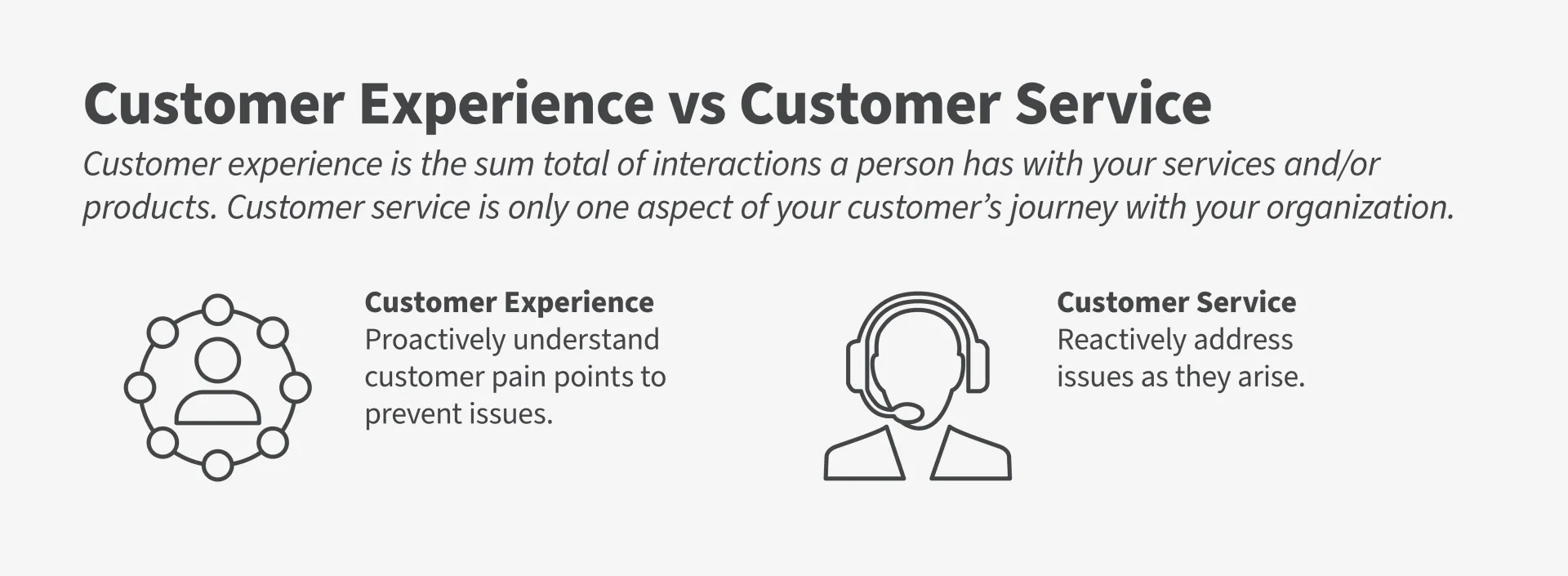Intro to CX Learning | 15 Minutes
Learning Objectives
- Understand that DHS has customers and identify who they are
- Understand what customer experience is
- Understand the difference between customer experience and customer service
- Understand the difference between customer experience, user experience, and user interface
Does DHS really have customers? Isn’t customer experience the same thing as customer service? What’s the difference between customer experience (CX), user experience (UX), and user interface (UI)?
These are some of the common CX questions we’re asked. Let’s answer them!
Does DHS Have Customers? Who Are They?
Below you will find several examples of our customers, but these are not all of the customers that DHS works with every day.
| Customer Types | Component |
|---|---|
| Passengers | Transportation Security Administration (TSA) |
| Disaster Survivors | Federal Emergency Management Agency (FEMA) |
| Businesses Importing & Exporting Goods | Customers and Border Protection (CBP) |
| Mariners | United States Coast Guard (USCG) |
| Immigrants, Refugees, & Asylum Seekers | United States Citizenship and Immigration Services (USCIS) |
| Federal Employees | All government employees are DHS customers |
We define our customers as individuals, businesses, and organizations that interact with a Federal Government agency or program, either directly or via a federal contractor or through a federally-funded program.
Our mission is to provide equitable, efficient, and effective services and products to all DHS customers. By learning about, investing in, and implementing customer experience as a practice, we can make sure the experience of every DHS customer is one that builds their trust in our ability to secure the homeland.
What Is Customer Experience (CX)?
Customer experience (CX) is the sum total of interactions a person has with your services and/or products and how they perceive your organization. It is a combination of these factors that come together to form the customer's overall experience.
Customer interactions happen at touchpoints with your organization on the customer’s journey to access your service or product. A touchpoint can be digital, human, or physical. Some examples of touchpoints include:
- Speaking with a DHS employee at a field office (human)
- Calling a Component contact center (human)
- Accessing a Component website (digital)
- Filling out a paper form for a DHS service (physical)
- Filling out a form on a DHS application (digital)
What Is the Difference Between Customer Experience and Customer Service?
Simply put, CX is a proactive approach to solving customer problems, and customer service is often reactive.
Customer Experience principles and practices help you gain a deep understanding of the touchpoints along the customer journey for each DHS service or product you provide to prevent major issues in service delivery. Conducting user research early and often to understand issues with existing products and services and testing improvements with real customers before they are implemented helps ensure you are delivering a truly effective, efficient, and equitable service or product.
Customer service, on the other hand, is the assistance and advice you provide to customers who buy or use your services or products. Oftentimes customer service occurs after a customer experiences a challenge or has a question about accessing your service.
If your organization is only providing customer service, you're missing a chance to get ahead of the challenges and pain points your customer might experience while trying to access your service before they happen.
Here's an example of the limits of customer service
A customer is feeling frustrated when they can’t figure out how to access a form on your service portal, but they don’t take the time to file a formal complaint about the situation with your call center.
In this example, where customer service cannot help the customer, customer experience can.
Customer experience practices like usability testing can uncover user issues like those with the website and form before they’re made available to the public. You can identify challenges and customer pain points ahead of a product release and make the appropriate adjustments to ensure those issues did not continue for future customers.
Customer service is only one aspect of your customer’s journey with your organization. And, when you provide good customer service, it is one way to help ensure that customers have a great experience with your products and services.
By broadening our focus to include the full scope of interactions our customers have with our organizations through CX practices, we can deliver the critical DHS services and products people rely on every day more efficiently, effectively, and equitably.
What Is the difference Between CX, UX, & UI?
Consider the difference between CX, UX, and UI as a tiered structure with CX encompassing UX and UI.
Customer Experience (CX) is the sum total of interactions a person has with your services and/or products and how they perceive your organization. This includes all types of touchpoints across physical, human, and digital spaces.
User experience (UX) is the experience a customer has with your organization during a journey across a single service/product. An example of UX can include analyzing if a customer can navigate a website to find, fill out, and submit a form successfully.
User interface (UI) is the webpage, digital form, menu screen, fillable PDF, or even paper form that a customer uses to complete one or multiple tasks in their journey to access your service or product.
In Summary
CX at DHS starts with knowing our customers—passengers, disaster survivors, immigrants, mariners, and other individuals and organizations—and their goals, needs, and behaviors. By engaging our customers to understand their needs and pain points before they engage us at a call center or help desk, CX practices like user research help us proactively assess and improve the quality of interactions our customers have with us, creating a better overall customer experience.
CX works to understand the whole experience of accessing a service or product, from the first e-mail to the last handshake and every form, application, and screen in between. By incorporating CX into how we design and deliver our services and products, we can create equitable, effective, and efficient services and products that help us build public trust in order to better protect the homeland.
Resources
Article:
What is Customer Experience? (DOI)
Web Resource:
Customer Experience Toolkit (Digital.gov)
Download:
Human Centered Design (HCD) Discovery Stage Field Guide V.1 (GSA)
Improving Federal Customer Experience and Service Delivery (GSA)
Video:
Equity-Centered Design: Challenges in Government (Digital.gov)



